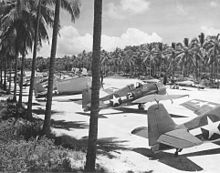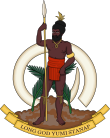History of Vanuatu

The history of Vanuatu spans over 3,200 years.
Premodern history
The pre-European history of Vanuatu can be reconstructed by combining insights from linguistics (particularly historical linguistics), anthropology, archaeology and human genetics.
Archaeological evidence supports that peoples speaking Austronesian languages first came to the islands some 3,300 years ago.[1] Pottery fragments have been found dating back to 1300 BC.[2]
The first inhabitants of Vanuatu were carriers of the
Around the 16th or 17th century AD, one important king was Roi Mata, who united several tribes in central Vanuatu. He was buried in a large mound with several retainers – a place which is now one of the UNESCO World Heritage Sites. The memory of Roi Mata is still told today in oral histories and legends.[6]
European contact

The Vanuatu group of islands first had contact with Europeans in 1606, when the Portuguese explorer Pedro Fernandes de Queirós, sailing for the Spanish Crown, arrived on the largest island and called the group of islands La Austrialia del Espiritu Santo or "The Southern Land of the Holy Spirit", believing he had arrived in Terra Australis or Australia. The Spanish established a short-lived settlement at Big Bay on the north side of the island. The name Espiritu Santo remains to this day.[7]
Europeans did not return until 1768, when
In 1825, trader Peter Dillon's discovery of sandalwood on the island of Erromango began a rush that ended in 1830 after a clash between immigrant Polynesian workers and indigenous Melanesians. During the 1860s, planters in Australia, Fiji, New Caledonia, and the Samoan Islands, in need of labourers, orchestrated a long-term indentured labour trade known as "blackbirding".[9] At the height of the blackbirding, more than one-half the adult male population of several of the islands worked abroad. Fragmentary evidence indicates that the current population of Vanuatu is greatly reduced compared to pre-contact times.[10]
It was at this time that
Settlers also came, looking for land on which to establish
Franceville

The municipality of Franceville (present-day
Condominium

The jumbling of French and British interests in the islands brought petitions for one or another of the two powers to annex the territory. The Convention of 16 October 1887 established a joint naval commission for the sole purpose of protecting French and British citizens, but claimed no jurisdiction over internal native affairs.[18]
In 1906, however, France and the United Kingdom agreed to administer the islands jointly. Called the British-French Condominium, it was a unique form of government, with separate governmental systems that came together only in a joint court. The condominium's authority was extended in the Anglo-French Protocol of 1914, although this was not formally ratified until 1922. Melanesians were barred from acquiring the citizenship of either power and were officially stateless; to travel abroad they needed an identity document signed by both the British and French resident commissioners.[10]
Many called the condominium the "Pandemonium" because of the duplication of laws, police forces, prisons, currencies, education and health systems.
Overseas visitors could choose between British law, which was considered stricter but with more humane prisons, or French law, which was considered less strict, but with much worse prison conditions.
In their book, Vanuatu by Jocelyn Harewood and Michelle Bennett, is this memorable passage referring to the 1920s: "Drunken plantation owners used to gamble... using the 'years of labour' of their Melanesian workers as currency. Islanders used to be lined up against the wall, at the mercy of their employers' dice. Long after America's
Starting in 1921, French plantation owners let Annamese workers from the Gulf of Tonkin come to the New Hebrides under 5 years contracts. They were 437 in 1923, 5413 in 1930, then after the crisis 1630 in 1937. There was some social and political unrest among them in 1947. In 1949 the plantation owners wished to replace Annamese by "more docile" Javanese. However, a French scholar suggested in 1950 a renewal of Annamese migration, but this time as settlers in villages of their own. A proposal because "It is difficult, indeed, to count on the natives. They live (...) a still wild life".[19]

Challenges to this form of government began in the early 1940s.
Decolonisation
Perhaps the final political impetus towards independence was the central issue of land ownership which arose during the 1960s. The ancient customs of the Ni-Vanuatu meant that land was held in trust for future generations by the current custodians;
".In the 1960s France opposed Britain's desire to de-colonize the New Hebrides, fearing that the independence sentiment would be contagious in their mineral-rich colonial possessions in French New Caledonia.[21]
The first political party was established in the early 1970s and originally was called the
"Coconut War"

Beginning in June 1980,
On 8 June 1980, the New Hebrides government asked Britain and France to send troops to put down a rebellion on the island of Espiritu Santo.[27] France refused to allow the United Kingdom to deploy troops to defuse the crisis, and French soldiers stationed on Espiritu Santo took no action. As independence day neared, the Prime Minister-elect, Walter Lini,[28] asked Papua New Guinea if it would send troops to intervene.[22] As Papua New Guinean soldiers began arriving in Espiritu Santo,[29] the foreign press began referring to the ongoing events as the "Coconut War".
However, the "war" was brief and unconventional. The residents of Espiritu Santo generally welcomed the Papua New Guineans as fellow
At Stevens' trial, the support of the Phoenix Foundation to the Nagriamel movement was revealed. It was also revealed that the French government had secretly supported Stevens in his efforts. Stevens was sentenced[23] to 14 years' imprisonment; he remained in prison until 1991.
Independent Vanuatu

On 30 July 1980, amidst the brief
Since independence, only kastom owners and the government can own land; foreigners and other islanders who are not kastom owners can lease land only for the productive life of a coconut palm - 75 years.
During the 1990s, Vanuatu experienced a period of political instability which resulted in a more decentralised government. The Vanuatu Mobile Force, a paramilitary group, attempted a coup in 1996 because of a pay dispute. There were allegations of corruption in the government of Maxime Carlot Korman. New elections have been held several times since 1997, most recently in 2016.
See also
References
- S2CID 53485887.
- ^ Ron Adams, "History (from Vanuatu)", Encyclopædia Britannica, 2006.
- ISBN 9781922185235.
- PMID 29487365.
- ^ "Vanuatu profile – Timeline". BBC News. 12 July 2017. Retrieved 17 May 2021.
- ^ Chris Ballard; Meredith Wilson (2008). Chief Roi Mata's Domain (PDF) (Nomination by the Republic of Vanuatu for Inscription on the World Heritage List).
- ISBN 978-1-74104-792-9.
- ISBN 9780520261143.
- ISBN 978-1-74104-792-9.
- ^ U.S. Department of State.
This article incorporates text from this source, which is in the public domain. - ISBN 0-520-06900-5.
- ISBN 978-1-4387-5649-3.
- ISSN 0030-8722. Retrieved 23 June 2021.
- ISBN 978-1-4402-2956-5.
- ^ Bourdiol, Julien (1908), Condition internationale des Nouvelles-Hebrides, p 107
- ^ Simpson, Colin (1955). Islands of Men: A Six-part Book about Life in Melanesia, p 133.
- ^ "Wee, Small Republics: A Few Examples of Popular Government," Hawaiian Gazette, 1 November 1895, p1
- ISBN 978-982-02-0342-6.
- ^ Charles Robequain, "Nouvelles-Hébrides et l'immigration annamite", Annales de Géographie, t. 59, n°317, 1950. pp. 391-392
- ^ Lindstrom 1991, pp. 49–53.
- ISBN 0-333-94975-7.)
{{cite book}}: CS1 maint: location (link - ^ a b Michael T. Kaufman (23 February 1999). "Walter Lini, 57, Clergyman Who Led Nation of Vanuatu". The New York Times. Retrieved 18 September 2009.
- ^ a b "South Pacific Rebel Seized". The New York Times via Reuters. 14 September 1982. Retrieved 18 September 2009.
- ^ "Pacific Islands in Election Battle". The New York Times. 1 November 1983. Retrieved 18 September 2009.
- ^ William Borders (12 June 1980). "British Answering New Hebrides Call; Company of Marines Being Sent 'to Provide Stability' French Antiriot Police Arrive Threat to Independence One Killed on 2d Island 55 French Riot Police Land". The New York Times. Retrieved 18 September 2009.
- ^ Treaster, Joseph B. (7 June 1980). "U.S. Land Developer Aids New Hebrides Dissidents". The New York Times. Retrieved 18 September 2009.
- ^ "New Hebrides Asks for Aid in Revolt; Plea Might Go to U.N." The New York Times. 8 June 1980. Retrieved 18 September 2009.
- ^ Bernard D. Nossiter (9 July 1981). "Vanuatu, New Pacific Nation, Moving Toward Seat at U.N." The New York Times. Retrieved 18 September 2009.
- ^ Graeme Dobell (26 June 2003). "Alexander Downer announces moves toward a new foreign policy – Transcript". PM. Retrieved 17 September 2009.
- ^ "New Hebrides Rebel Urges Peace; Willing to Fight British and French One British Officer Injured". The New York Times. 9 June 1980. Retrieved 18 September 2009.
Bibliography
- Lindstrom, Lamont (1991). "Remembering the Pacific War". Occasional Papers of the Center for Pacific Islands Studies. Center for Pacific Studies: 47–59. ISSN 0897-8905.

